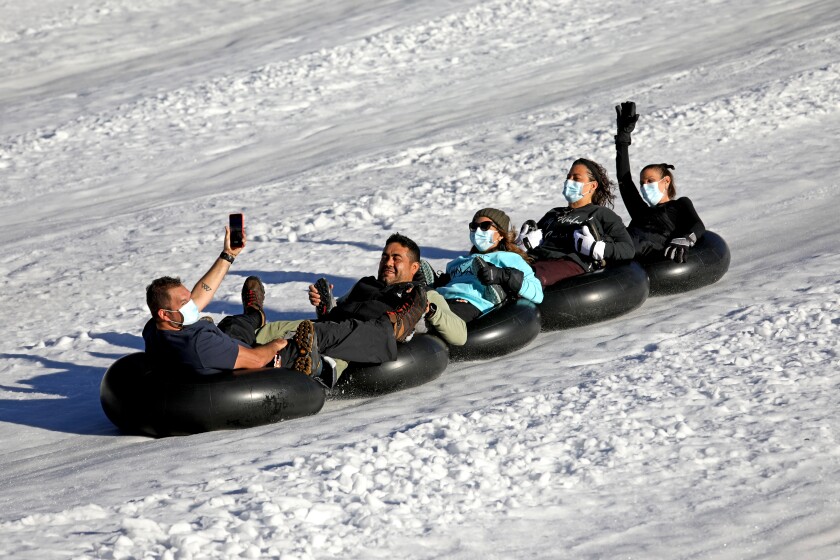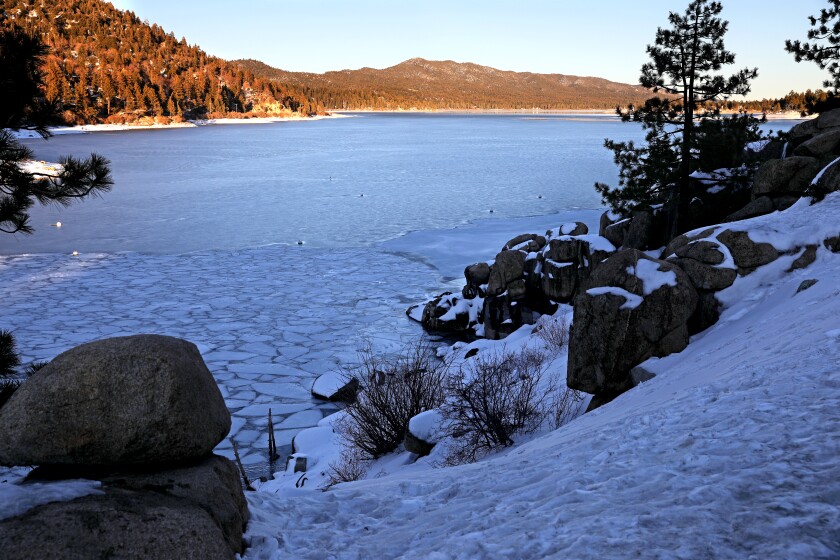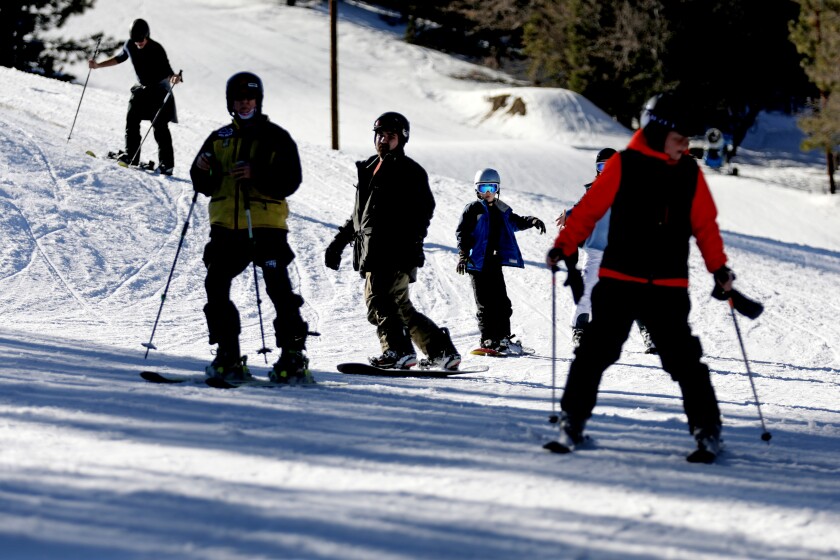John Gabin sat with his skis at a picnic table nearby, looking up at the steep, snow-covered slopes. His four year old son was stretched out on his outstretched legs.
“It’s a getaway from LA, the city, you know?” Said Gabin, 46, of North Hollywood, who rented a house in Big Bear Lake for several days with his wife, two children, and a friend.
He spent the sunny weekday mornings in January at the Snow Summit Resort teaching his children to ski, a pastime he has been practicing in France since childhood. Now there is a means of escaping the sustained surge in coronavirus cases as the Omicron variant is rapidly spreading in the dense neighborhoods of Los Angeles.
“Since Christmas it’s been positive, negative, contact, no contact,” he said. “It’s crazy. There’s nowhere to be tested. It’s a lot of stress. That’s why we have to go.”
Mountain resorts like Big Bear have long been Southern California vacation or day trip destinations, but during the pandemic and an early winter of healthy snowfall, visitor numbers have increased as people seek out activities that still allow social distancing and other safety measures to avoid them of infections, officials and business owners said.
But while the influx of visitors bodes well for the local economy, it has put a strain on Bear Valley’s infrastructure and workforce. During this and last winter season, residents, workers and business owners in Big Bear have to contend with increased exposure to the coronavirus, understaffing, shortages of basic services, housing shortages, traffic and parking jams, and garbage.
“We are experiencing, in a microeconomic sense, the problems everyone else is facing across the country,” said Ellen Clarke, executive director of the Big Bear Chamber of Commerce. “Only in our small community do we have a very small population, and it hurts – it hurts a lot.”
Clarke said staffing issues had hit small businesses with 10 employees or fewer the hardest.
Brody Barr helps clients Justin and Brandon Han of Whittier at Johnny’s Ski and Board House in Big Bear Lake.
(Gary Coronado / Los Angeles Times)
Brody Barr, who works at a ski and snowboard rental shop on Big Bear Lake’s main thoroughfare, said the increased crowd was a welcome sight, but the staff shortage meant that he and other employees had to work overtime during the holidays. He said many of the store’s customers are first-time skiers or snowboarders who took up the sport during the pandemic. Many had never set foot on the mountain.
The influx was particularly difficult this year as workers were still affected by the COVID-19 death of the store’s longtime owner in December, Barr said.
“It’s very likely that he signed it here,” said Barr. “Not only do we get a lot of people from San Diego and Los Angeles, but also people from all over the world who come here.”
The death has resulted in more workers in the store being more cautious about the safety of COVID-19 at work, Barr said.
“Between people with COVID or the fear of getting COVID has really hampered both hiring and employee retention,” said Clarke of the Chamber of Commerce.
At one of the local grocery stores, about 30 employees were down and the drivers of the shuttle system that transports visitors to and from ski resorts drove away in droves, Clarke said.
Larger companies like Snow Summit, which is owned by a conglomerate based in Aspen, Colorado, said they were also affected by staff shortages, with some of their employees recently testing positive for the coronavirus.
The ski and snowboard season is in full swing in mountain resorts like Big Bear, where the nodules run at Alpine Slide on Magic Mountain.
(Gary Coronado / Los Angeles Times)
“We’re not in some kind of bubble or exempt from what everyone else is experiencing,” said Justin Kanton, a spokesman for Snow Summit.
Matthew Miller, who grew up in Big Bear Lake and now owns a small chain of ski and snowboard rentals primarily on Highway 18, said several of his employees had tested positive for the coronavirus in recent weeks. Most of his employees, including himself, contracted the disease last winter. Fewer people are applying now.
Most days he takes calls and tries to convince people to work for him while he runs between his stores and tries to plug holes in his business.
“Sometimes it’s just too hectic and crowded,” says Miller, who lives in Redlands and drives up the mountain four to five days a week. He waved to a couple who were hauling several snowboards from one of their stores in Running Springs, about a half-hour drive from Big Bear.
“This year was like the perfect storm,” said Miller. “We had snow, to be honest a couple of days before Christmas. The streets could be cleared by Christmas, and then boom, it was kind of crazy. “
Miller said he had seen many skiers and snowboarders walk through his shop for the first time since 2020, particularly amid lockdowns he called “a billboard for the mountains”.
A large storm system in December covered mountain resorts like Big Bear Lake.
(Gary Coronado / Los Angeles Times)
“Once you’re over 5,000 feet, people just seem to do what they want. You just feel more liberated, ”he said with a smile and looked through the doors of his shop at the mountains of snow that pile up next to the highway that leads to Big Bear. “That’s the mountain air, man.”
But there are many other problems associated with this feeling of liberation.
Illegal parking remains a major problem for cities like Big Bear Lake, where some visitors frequently block homeowner driveways or park on people’s lawns, said Ryan Orr, city spokesman. Some visitors enter private property to have snowball fights and push their sleds.
Broken plastic sleds in bright yellow, pink, or green dotted the white hills are a common sight in town in winter, Orr said. Some visitors leave rubbish behind. Some local residents have found used diapers by the lake while there have been reports of people pooping and urinating along the highways.
In response, the city hired two law enforcement workers and funded two deputies from the San Bernardino County Sheriff’s Department who have stepped up enforcement on issues such as parking and, since December, have distributed more than 600 parking orders, each with a fee of 100 Raised US dollars. 17, said Orr.
“We welcome our visitors. That’s the only reason we exist. It is not an illusion that we are a tourist city, ”Orr said. “And quotes are our last resort. We really want to teach people to use common sense and treat our home like their home. “
Traffic jams were a nuisance to visitors and locals alike, with some estimating trips from the base of the mountain to Big Bear to be three to four hours. Barr said his commute from Big Bear Lake to his home in Big Bear City, about seven miles away, could take up to two hours during rush hour. One factor is the partial closure of Highway 18, which was damaged by heavy rain and snowfall.
And in the San Gabriel Mountains, first responders in Wrightwood said traffic jams in the mountains made it hard to get emergency calls.
Plus, Big Bear’s visitor boom has pushed the already tight housing market further, resulting in higher rents and fewer options for permanent residents.
Skiers and snowboarders at the Snow Summit in Big Bear.
(Gary Coronado / Los Angeles Times)
As more people sought alternative living conditions in urban cities and suburbs in 2020 while much of their work and schooling remained remote during the lockdown, demand for short-term rentals in rural areas like Big Bear soared and the value of housing soared Height. Similar trends were seen in other rural vacation towns to the west, such as Lake Tahoe, Aspen, and Park City.
To meet that growing demand in Big Bear, there were second home owners who didn’t live in the mountains all year round, said Larry Vaupel, who heads the town’s tourism division. They own the vast majority of Big Bear Lake’s 10,000 homes.
To capitalize on the boom, 400 second home owners converted their homes into vacation rentals, an increase of 20%, said Vaupel.
The brunt of the real estate boom was borne by long-term renters, who often work low-wage service jobs at the area’s resorts, some of which have failed to keep pace with rising rents and have been evicted from their homes, Vaupel said.
On a resident Facebook group, Barr said he recently heard of two single mothers who were evicted. He said it was common for people to post such announcements on the site and other residents to offer temporary assistance such as donations or a room or couch to sleep in until they are back on their feet.
“It comes down to a source of greed,” Barr said of the influx of rising rents and vacation rentals.
Permanent residents of Big Bear also had less access to essential services like electricians and plumbers, who were overwhelmed by the number of second home owners converting their homes into vacation rentals, Clarke told the Chamber of Commerce.
And for companies, the lack of affordable housing has only made their struggle to hire and retain workers worse, Clarke said.
She heard of a company that had an ideal candidate from a town below the mountain. Although they offered her the job, they couldn’t hire her because she couldn’t find an apartment in town.
Although solutions to housing problems remain uncertain, the city has taken other steps to strengthen its infrastructure, such as installing more public toilets and dumpsters for visitors, more bike paths and additional parking at the trailheads, Vaupel said.
“I think we learned a lot of lessons from 2020 – the lessons are tough and they came quickly,” he said.
Meanwhile, Clarke looks after the workers, and subordinate small business owners like Barr and Miller prepare for another weekend push each week.
“You work incredible hours,” said Clarke. “They are worn out – the whole community is worn out.”





Comments are closed.